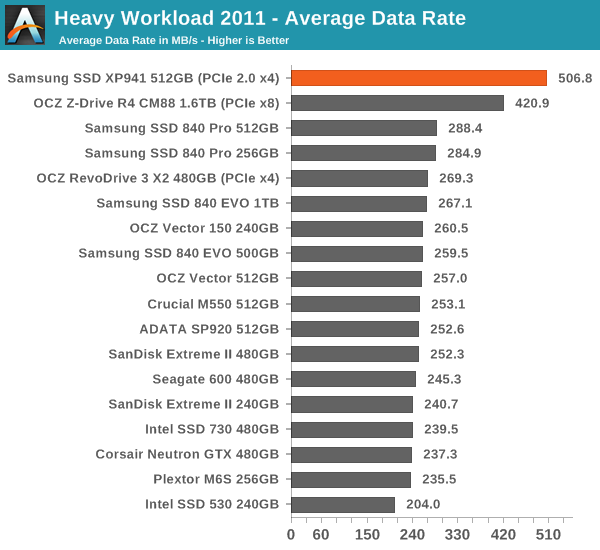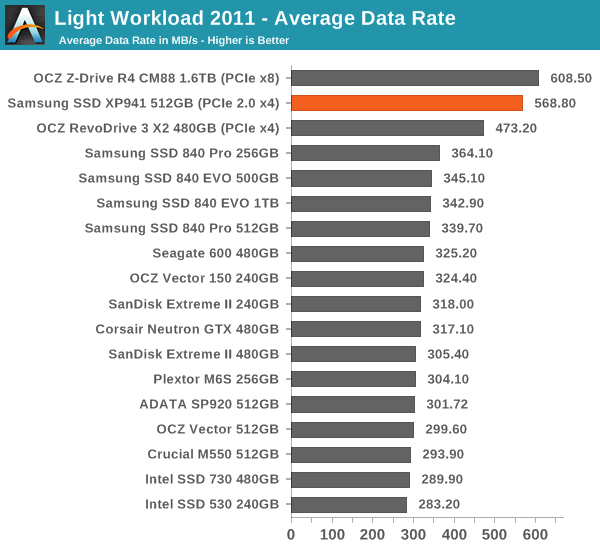Samsung SSD XP941 Review: The PCIe Era Is Here
by Kristian Vättö on May 15, 2014 12:00 PM ESTAnandTech Storage Bench 2011
Back in 2011 (which seems like so long ago now!), we introduced our AnandTech Storage Bench, a suite of benchmarks that took traces of real OS/application usage and played them back in a repeatable manner. The MOASB, officially called AnandTech Storage Bench 2011 - Heavy Workload, mainly focuses on peak IO performance and basic garbage collection routines. There is a lot of downloading and application installing that happens during the course of this test. Our thinking was that it's during application installs, file copies, downloading and multitasking with all of this that you can really notice performance differences between drives. The full description of the Heavy test can be found here, while the Light workload details are here.

The same goes for our 2011 Storage Bench: the XP941 is unbeatable. Only in the Light Workload test, the 8-controller OCZ behemoth is able to beat the XP941 by a small margin, but other than that there's nothing that can challenge the XP941. The consumer-oriented OCZ RevoDrive comes close but the XP941 once again shows how a good single controller design can beat any RAID 0 configuration.











110 Comments
View All Comments
UltraWide - Friday, May 16, 2014 - link
The random read/write scores are too low for this SSD to make a difference in real world use. I think it's better to wait for the 2nd generation of M.2 to see some more mature controllers with improved IOPS or random read/write speeds.DaveGirard - Friday, May 16, 2014 - link
It would be nice if you could test one of these in an external Thunderbolt 1/2 PCI chassis.RamCity - Friday, May 16, 2014 - link
That sure is a good idea, and Rob over at barefeats.com tested the XP941 (installed in a standard PCIe adapter) in a thunderbolt chassis but maxed out one thunderbolt port at 1375MB/s, no matter how many XP941's are installed. To get higher throughput the chassis now need individual thunderbolt ports per SSD installed.His review is about halfway down here: http://barefeats.com/hard183.html
Rod (vendor rep for RamCity.com.au)
Peeping Tom - Friday, May 16, 2014 - link
The picture of the M.2 above gave me an idea. It would be interesting if storage capacity could be expanded like RAM using multiple M.2, i.e. plug and play. You insert a new stick and the system automatically expands the current partition to include the new drive (rather than creating new, separate partition). No more SATA/power cables, and it would make the system more uniform with the existing RAM/slot architecture. Would take many lanes thoughpoordirtfarmer2 - Saturday, May 17, 2014 - link
Or how about the card being lots longer - a daughter card of sorts - and allow for slapping additional SSD modules to it as the user needs (or can afford).Laststop311 - Sunday, May 18, 2014 - link
Waiting for pci-e 3.0 x4 m2 connectors before buying the rushed tech on and older backbone.Marucins - Monday, May 19, 2014 - link
ASRock Z97 Extreme6 - PCIe 2.0 x4http://nimg.cdrinfo.pl/2014/05/Samsung-XP941-M.2-S...
Marucins - Monday, May 19, 2014 - link
Any information X99, that will support M.2 and SATA Express??Laststop311 - Monday, May 19, 2014 - link
This drive can only be used in the Asrock Extreme9 board as it's the only m2 that actually uses pci-e x4 right off the cpu instead of the PCH.Laststop311 - Monday, May 19, 2014 - link
Sorry and one of thos big pci-e riser cards that turns any slow into a board with an m2 slot. Defeats the small form factore person tho,